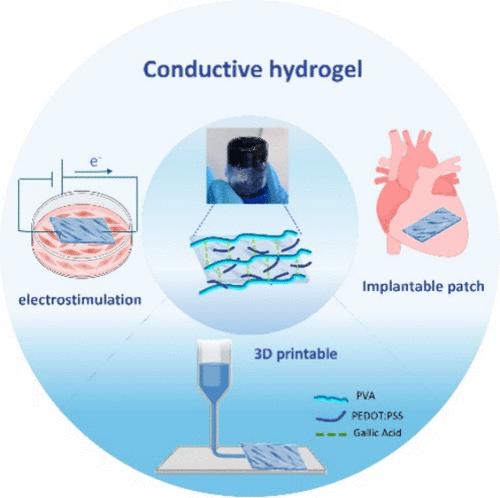当前位置:
X-MOL 学术
›
ACS Appl. Mater. Interfaces
›
论文详情
Our official English website, www.x-mol.net, welcomes your feedback! (Note: you will need to create a separate account there.)
Printable Poly(3,4-ethylenedioxythiophene)-Based Conductive Patches for Cardiac Tissue Remodeling
ACS Applied Materials & Interfaces ( IF 8.3 ) Pub Date : 2024-06-27 , DOI: 10.1021/acsami.4c03784 Gisela C. Luque 1, 2 , Matías L. Picchio 3 , Bahaa Daou 2, 4 , Haizpea Lasa-Fernandez 1 , Miryam Criado-Gonzalez 3 , Ramon Querejeta 5 , David Filgueiras-Ramas 6 , Maurizio Prato 1, 7, 8 , David Mecerreyes 3, 8 , Jesús Ruiz-Cabello 1, 8, 9, 10 , Nuria Alegret 1, 3, 4
ACS Applied Materials & Interfaces ( IF 8.3 ) Pub Date : 2024-06-27 , DOI: 10.1021/acsami.4c03784 Gisela C. Luque 1, 2 , Matías L. Picchio 3 , Bahaa Daou 2, 4 , Haizpea Lasa-Fernandez 1 , Miryam Criado-Gonzalez 3 , Ramon Querejeta 5 , David Filgueiras-Ramas 6 , Maurizio Prato 1, 7, 8 , David Mecerreyes 3, 8 , Jesús Ruiz-Cabello 1, 8, 9, 10 , Nuria Alegret 1, 3, 4
Affiliation

|
Myocardial cardiopathy is one of the highest disease burdens worldwide. The damaged myocardium has little intrinsic repair ability, and as a result, the distorted muscle loses strength for contraction, producing arrhythmias and fainting, and entails a high risk of sudden death. Permanent implantable conductive hydrogels that can restore contraction strength and conductivity appear to be promising candidates for myocardium functional recovery. In this work, we present a printable cardiac hydrogel that can exert functional effects on networks of cardiac myocytes. The hydrogel matrix was designed from poly(vinyl alcohol) (PVA) dynamically cross-linked with gallic acid (GA) and the conductive polymer poly(3,4-ethylenedioxythiophene) (PEDOT). The resulting patches exhibited excellent electrical conductivity, elasticity, and mechanical and contractile strengths, which are critical parameters for reinforcing weakened cardiac contraction and impulse propagation. Furthermore, the PVA-GA/PEDOT blend is suitable for direct ink writing via a melting extrusion. As a proof of concept, we have proven the efficiency of the patches in propagating the electrical signal in adult mouse cardiomyocytes through in vitro recordings of intracellular Ca2+ transients during cell stimulation. Finally, the patches were implanted in healthy mouse hearts to demonstrate their accommodation and biocompatibility. Magnetic resonance imaging revealed that the implants did not affect the essential functional parameters after 2 weeks, thus showing great potential for treating cardiomyopathies.
中文翻译:

用于心脏组织重塑的可印刷聚(3,4-乙烯二氧噻吩)基导电贴片
心肌病是全世界负担最重的疾病之一。受损的心肌缺乏内在修复能力,扭曲的肌肉失去收缩力,产生心律失常和昏厥,猝死的风险很高。可以恢复收缩强度和电导率的永久植入式导电水凝胶似乎是心肌功能恢复的有希望的候选者。在这项工作中,我们提出了一种可打印的心脏水凝胶,它可以对心肌细胞网络发挥功能作用。水凝胶基质由与没食子酸(GA)动态交联的聚乙烯醇(PVA)和导电聚合物聚(3,4-乙撑二氧噻吩)(PEDOT)设计。所得贴片表现出优异的导电性、弹性以及机械和收缩强度,这些是增强减弱的心脏收缩和脉冲传播的关键参数。此外,PVA-GA/PEDOT 共混物适合通过熔融挤出进行直接墨水书写。作为概念证明,我们通过体外记录细胞刺激过程中细胞内 Ca 2+ 瞬变,证明了贴片在成年小鼠心肌细胞中传播电信号的效率。最后,将贴片植入健康小鼠心脏,以证明其适应性和生物相容性。磁共振成像显示,两周后植入物并未影响基本功能参数,因此显示出治疗心肌病的巨大潜力。
更新日期:2024-06-30
中文翻译:

用于心脏组织重塑的可印刷聚(3,4-乙烯二氧噻吩)基导电贴片
心肌病是全世界负担最重的疾病之一。受损的心肌缺乏内在修复能力,扭曲的肌肉失去收缩力,产生心律失常和昏厥,猝死的风险很高。可以恢复收缩强度和电导率的永久植入式导电水凝胶似乎是心肌功能恢复的有希望的候选者。在这项工作中,我们提出了一种可打印的心脏水凝胶,它可以对心肌细胞网络发挥功能作用。水凝胶基质由与没食子酸(GA)动态交联的聚乙烯醇(PVA)和导电聚合物聚(3,4-乙撑二氧噻吩)(PEDOT)设计。所得贴片表现出优异的导电性、弹性以及机械和收缩强度,这些是增强减弱的心脏收缩和脉冲传播的关键参数。此外,PVA-GA/PEDOT 共混物适合通过熔融挤出进行直接墨水书写。作为概念证明,我们通过体外记录细胞刺激过程中细胞内 Ca 2+ 瞬变,证明了贴片在成年小鼠心肌细胞中传播电信号的效率。最后,将贴片植入健康小鼠心脏,以证明其适应性和生物相容性。磁共振成像显示,两周后植入物并未影响基本功能参数,因此显示出治疗心肌病的巨大潜力。






































 京公网安备 11010802027423号
京公网安备 11010802027423号